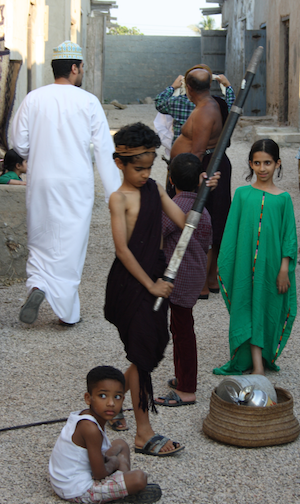
When Phillips lived in Oman people dressed like in this filmset in Mirbat. Even though an outsider and a man he seemed to have no difficulties to find out about FGM.
By Stop FGM Middle East
Salalah, 3.12.2013. In recent years there have merely been rumors that female genital mutilation is practiced in Oman. Some bloggers wrote about it. In UN publications, the country was mentioned occasionally in reference to FGM, but no one seemed to know more. Most people seemed to believe that it exists only in the Southern region of Dhofar bordering Yemen – and thus was a phenomenon connected to Yemeni culture.
Now, Wadi’s Stop FGM in the Middle East team is visiting the country on a fact finding mission. We are speaking with those people who reported on its existence, with journalists, potential actors and diplomats. Our findings are clear: FGM is practiced in all regions of Oman even though probably not by all ethnic and religious groups. It also varies in severity: While in Dhofar large parts of the female genitalia are supposedly cut the practice in the North seems less severe. We also heard several times that it exists in other gulf countries like the United Arab Emirates, Bahrain and even Saudi Arabia.
Internationally, the existence of FGM in the gulf regions was long denied. Yet, knowledge about FGM in Oman is not new at all. An archeologist and consultant to the Omani Sultan has reported on it already in the 1960s. Wendell Phillips writes in his book “Unknown Oman”: “Among the Qara (inhabitants of the mountains behind Salalah), radical clitoridectomy – or complete female circumcision (…) – is clumsily and brutally performed without ceremony at the birth of the female child. In the rest of Oman the little girl merely has the top of her clitoris, which is regarded as the prime center of sexual excitability, incised at the age of ten or soon after birth a bit of fine rock salt is placed on her clitoris which is then eliminated (rubbed away) by the insertion of a finger.” (p.174)
Phillips who lived on and off in Oman during the 1950s and 60s also analyses the social consequences of the practice: “If the truth were told a high percentage of Arab wives are among the world most embittered and frigid, while the Arab male is among the world’s unhappiest husbands. In his supreme effort to insure martial fidelity the Omani husband in numerous instances has equipped himself with up to four unresponsive ice cold mates whose genital organs have been deliberately mutilated by having the clitoris cut out along with its foreskin and in extreme cases the sanguinary ablation of the labia minora as well, thus eliminating in most instances all female pleasure and sensation during sexual intercourse and, to the self-centered male, any possible desire in his females to indulge in extra marital relations.” (p. 136)
Phillips analyses clearly a consequence long ignored in the discourse about FGM. The practice was always adressed as a medical problem. Only in recent years, sexual and social aspects came into focus, e.g. a Saudi study examines the connection of sexual dysfunction and FGM. The first thing one journalist asked us here in Oman concerned the connection of divorces and marital problems.
Our contacts here are convinced that FGM could be eliminated within few years in Oman if only a campaign was initiated. Education level is high and people are generally responsive to government campaigns, we heard.
It could be asked why international organizations have so long ignored Oman and other gulf countries when evidence was so clear and success through a campaign seems quite possible.

[…] Oman: Precise descriptions of FGM already in the 1960s […]